| |
|
|
| |
Some rain at last.
Sat 20th April, 2013
|
|
|
|
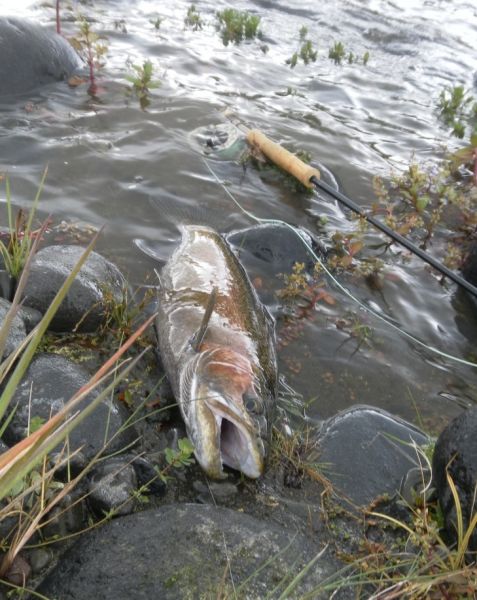 I was awakened in the early hours by a sound I hadn’t heard for a while … heavy rain. It’s a noise that always reminds me of growing up back in Wales. Those of us of a certain age will remember the old days of analogue telly before hundreds of digital channels and round the clock television. I was awakened in the early hours by a sound I hadn’t heard for a while … heavy rain. It’s a noise that always reminds me of growing up back in Wales. Those of us of a certain age will remember the old days of analogue telly before hundreds of digital channels and round the clock television.
When I was a kid in fifties Britain we had the BBC and that was it. In those days they only broadcast at certain times of the day and stopped altogether each evening at 11.00 pm. Every time transmission ended the picture was replaced by a blizzard of white noise on the screen which sounded exactly like rain falling. But on this occasion it had a different significance for me and hopefully signaled the beginning of the end of the dry spell and the possibility of some better fishing.
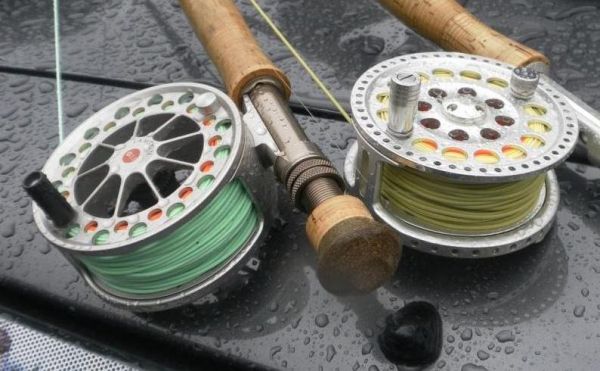 I’d arranged to pick up Terry Trout from TRM at eight o’clock for a final fish together before he flew back to the blistering heat of sun drenched Wales. They'd forecast frequent showers but as I put the gear in the truck the rain was already starting to ease. I’d arranged to pick up Terry Trout from TRM at eight o’clock for a final fish together before he flew back to the blistering heat of sun drenched Wales. They'd forecast frequent showers but as I put the gear in the truck the rain was already starting to ease.
There's precious little wild rainbow trout fishing in the UK and like thousands of others from all over the world Terry is prepared to fork out thousands of dollars to travel halfway round the globe for that experience. It’s important to overseas anglers and a huge draw card sometimes over-looked by the powers that be.
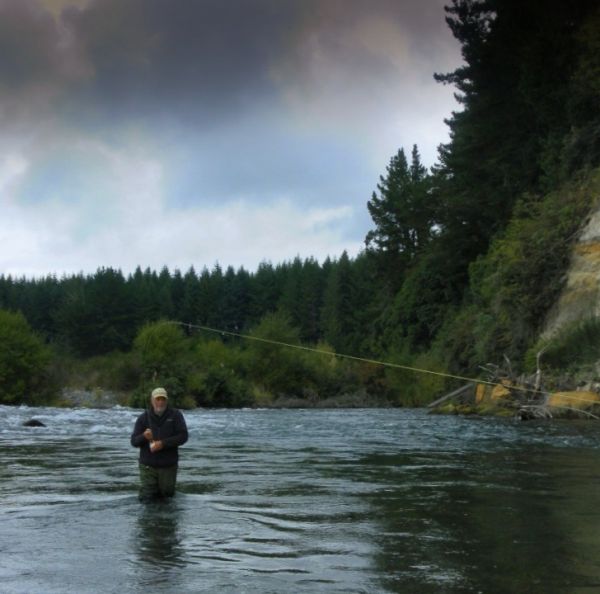 Terry has been coming to New Zealand in March since 2000 but he's been unlucky this trip. The timing of the spawning runs has changed dramatically since his first visit and this year he also had the drought to contend with. So I have a feeling future trips will be much later in the year. Terry has been coming to New Zealand in March since 2000 but he's been unlucky this trip. The timing of the spawning runs has changed dramatically since his first visit and this year he also had the drought to contend with. So I have a feeling future trips will be much later in the year.
We decided to head upriver to a few spots he hadn't tried before but after an hour or so we were still without a fish. By the time we got above Boulder Reach the skies had began to darken again and it started to pick with rain.
We spotted a few fish feeding in a deep run just above the tail of one pool but despite Terry putting several good drifts through they completely ignored his nymphs. He'd noticed me chopping and changing flies all morning and as I changed his fly again asked me if
I thought it made a difference on a river like the Tongariro. His question was answered when the indicator disappeared next cast.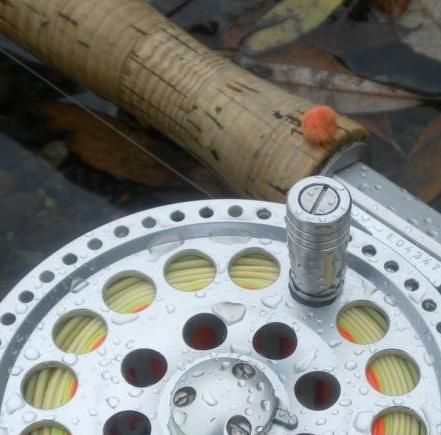
Fly choice isn't rocket science. If you have a basic knowledge of the food items available to trout in the river and observe whats going on around you, then you can load the odds in your favor.
In this instance I knew from previous sessions that just around the corner there were some very obvious signs that fish had been spawning.
Because of the heavy showers across the country the river was just beginning to color up slightly. And as the flow increased there was a fair chance some eggs were being carried down from stretches upstream of us.
A change to an orange globug did the trick.
Just to clarify something here because I don't want to mis-lead you. I'm not suggesting this trout took the globug because the river had started to color up. In fact there was only a hint of color and we could still clearly see the bottom.
Trout are opportunist drift feeders and when enough of a particular food source comes their way they'll eat it. So when fish are actively spawning throughout the river the fish will eventually switch on to this new food supply. This is the reason egg flies are mainly effective during the spawning runs.
Globugs can work just as well in clear conditions providing there are enough eggs in the water to make them a worthwhile alternative to naturals. But anglers find them useful in murky conditions because of their bright colors or size. Even a size 14 globug is much easier to spot than a size 14 nymph.
The next day provided another example of how keeping an eye on whats happening around you {and adapting} can make the difference between success or failure.
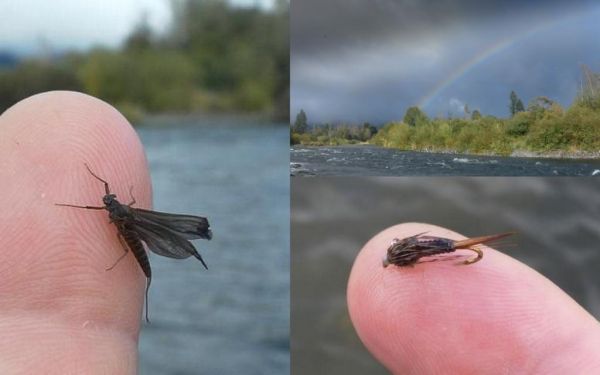 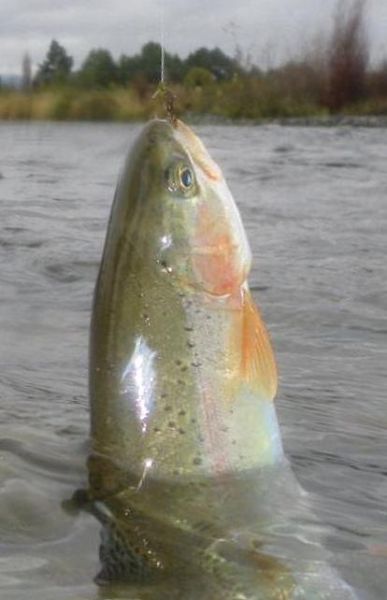
I had breakfast with Terry before he left for the airport and got on the river about ten o'clock.
After another night of heavy showers and with the river level slowly beginning to creep back up I thought it might be a good idea to stay around town just in case a few fish had decided to run.
By the time I got into Judges it was up to thirty cumecs and only just beginning to dirty up.
This time I tried a small globug first but after half an hour had no takers. Then I noticed the birds working just upriver and soon a steady trickle of Deleatidium duns began floating past.
There was no sign of fish taking the dun at the surface but I switched rods anyway and tied on a suitable pattern to mimic the emerging nymph. I fished this as the point fly under the big dry and first drift down connected with the jack pictured above. Next cast produced a fish around a pound and a half and I completely missed the third take.
Within fifteen minutes it was all over and it was as if there wasn't a fish in the river again.
Creel tackle carry a great Deleatidium nymph pattern which works well on the Tongariro tied in size 14. This is one of the most common mayfly found in New Zealand waterways so its well worth stocking up with a few.
I don't think any of us get through a day without the subject of the weather cropping up in conversation. Because of its geographical position getting an accurate daily weather forecast for Turangi is always difficult. But the Met Service issue a Seasonal Outlook which I find useful and you can look out of the window to fill in the gaps.
Seasonal Weather Outlook - issued 10 March 2013
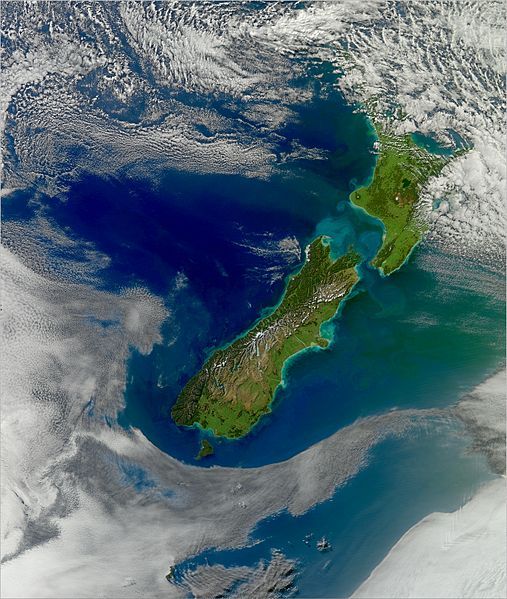
Dominant anticyclones and a few passing troughs.
Anticyclones have been the dominant feature across New Zealand over the past several weeks.
There have been a few weak troughs scattered into the mix but none of great note. The large anticyclone of late January/early February became stuck in place , or blocked, for more than a week but since then the upper level winds have kept the weather features on the move.
A spell of south-westerly's spread across New Zealand during mid- February and early March yet most of the fronts moving through in the flow were moisture limited so did not provide great relief to dry conditions.
Keep an eye out for possible further blocking,when weather systems get stuck in place, in the next several weeks.
The Ocean.
The Pacific Ocean plays a major part in influencing our weather patterns. The critical area to assess sea-surface temperatures is along the equator, between the date line (180 degrees longitude) and Central America. When this area is cooler than normal we call the corresponding pattern a La Nina. This gives strong trade winds and encourages the high-pressure regions near New Zealand to be further south than normal. The opposite pattern is called an El Nino: it has weak trade winds, and causes the westerlies of the "roaring 40s" to shift northwards over New Zealand. The conditions in the Pacific waters are still described as neutral and this trend is forecast to continue for the next several months. Equatorial sea surface temperatures warmed during the end of 2012 and then cooler across eastern areas by the start of 2013. The cooler zone has relaxed slightly but still exists across eastern equatorial regions. The sea surface temperature across the western equatorial Pacific is still slightly warmer than normal. In the subsurface the recent negative temperature anomalies have weakened in the east-central Pacific. Generally in a neutral scenario our weather patterns become more varied which widens the extremes of wind, rain and temperature. This also allows other factors to come into play to influencing our day to day weather. The sea surface temperature pattern around New Zealand also plays a factor in determining our seasonal weather especially when other factors are not as strong. Slightly warmer-than-normal seas still exists from the Solomons down to the southeast of Fiji. The water to the south of New Caledonia down to just north of New Zealand has cooled slightly over the past few weeks but the waters surrounding New Zealand are still about to just above normal.
The Atmosphere
Atmospheric weather patterns continue to fluctuate as they have done so over the past few months. Barometer readings from Tahiti and Darwin are used to calculate the Southern Oscillation Index (SOI). Over the past three months this has been hovering around zero but it took a dip at the end of 2012 with some hints of El Nino perhaps the cause. This also may have helped bring about the brief northern shift in the "Roaring Forties" along with the extreme heat that parts of Australia experienced at the beginning of 2013. In February it dipped below zero again and it is still just negative and within neutral territory. When it comes to seasonal outlooks it is enticing to try and compare the coming season with a close analogy from the recent past. In 2009 we had a neutral/weak El Nino and in 2001 the season remained neutral, these years may also provide partial guidance, however bear in mind in a neutral state,variability is the norm and local influences can help shape the seasonal weather too.
Still neutral
The neutral conditions across the Pacific will bring an element of variety in the weather we experience over the next several weeks. The dominant anticyclones of the past few weeks will still be a factor in our weather in the coming weeks but perhaps to a lesser degree. Anticyclones will continue to track across central New Zealand over the next several weeks bringing extended periods of dry weather, particularly if they linger for several days due to upper level blocking. The seasonal shift north of the anticyclonic ridge axis will cause them to track more across central regions and then perhaps to northern New Zealand by April/May. Between the anticyclones, fronts and troughs are expected to cross the country. During autumn we should see a slow transition to more active weather. In mid to late March, low pressure systems are likely to move from the subtropics onto the north and east of the country, bringing wet and windy days. By the end of March we should see a return of fronts moving across New Zealand from the Tasman Sea. In April or May a pattern change is likely with more active fronts moving from the Tasman Sea and/or Southern Ocean onto the South Island. The risk of a cyclone moving from the tropics onto New Zealand starts to fade in April.
How to fine-tune these ideas to your area.
These outlooks are based on the best information available at issue time and are meant for general guidance. No guarantees are offered, but a level of outlook confidence is expressed. The scale of a seasonal outlook is different in time and space from that of day-to-day weather forecasts. Our seasonal outlooks describe conditions averaged over the next six weeks and do not represent any particular day. Regions are grouped together according to how they are expected to vary from the norm, even though the weather may well differ across a group. So apply the variations we mention here to your own norms of temperature and rainfall (which vary from place to place and from season to season).
Taumarunui, Taihape, Taranaki, Taupo
RAIN: about to perhaps just below normal after a drier than normal February.
WIND: continuing about normal.
TEMPERATURE: continuing to about just above normal.
SUNSHINE: continuing to about just above normal.
SPECIALS: returning troughs.
CONFIDENCE: moderate
This is the time of the year for extended dry periods as high pressure systems cross central New Zealand. The cooler mornings will have an increasing impact with more mist and dew. Warm days are still likely to produce afternoon showers inland, resulting in some places being wetter than others. The best chance for rain at this time of the year comes from a low pressure system approaching from the north, but even these systems may end up only wetting eastern and south-eastern flanks.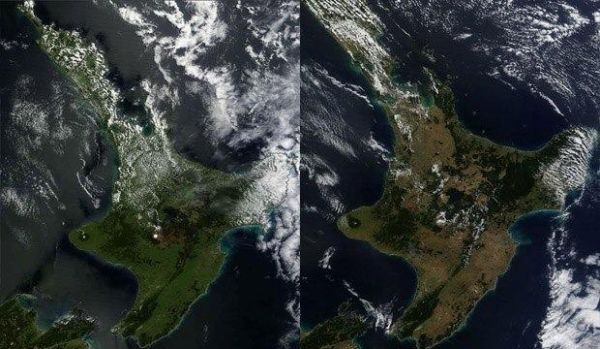
Climate scientists have predicted that the drought is likely to be felt well into autumn, as river and soil moisture levels in the North Island take some time to recover.
The National Institute of Weather and Atmospheric Research seasonal climate outlook for April to June has predicted higher than average temperatures across the North Island, and lower than normal river flows and soil moisture levels in the north of the North Island.
The continuing dry conditions come despite the likelihood of near normal rainfall throughout the country.
"Because of the existing soil moisture deficits across the North Island and in the eastern South Island, soil moisture levels and river flows are expected to take some time to recover in these areas," Niwa said.
In Northland, Auckland, Waikato and Bay of Plenty, temperatures are likely to be above average.
Rainfall is likely to be near normal, while soil moisture levels and river flows are likely to be below normal.
Similar conditions are likely for the rest of the North Island, except for soil moisture levels, which are likely to be near or below normal.
Summary
There's a much more autumnal feel along the river this week. And as the days become shorter the deciduous trees will continue to shut down ... producing that fantastic display of rich reds and yellows that we enjoy each year.
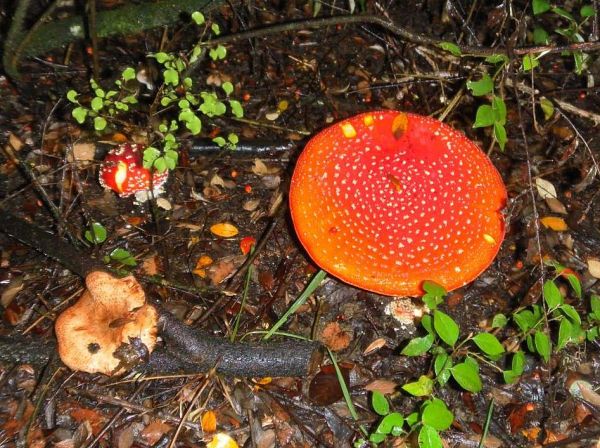 Another autumn phenomenon which you"ll come across while walking along the Tongariro access tracks is this toadstool. Its commonly called the fly agaric and is often found near deciduous or coniferous trees. Another autumn phenomenon which you"ll come across while walking along the Tongariro access tracks is this toadstool. Its commonly called the fly agaric and is often found near deciduous or coniferous trees.
The reference books label it as poisonous.
But in some countries this fungus is routinely eaten as a food after its been parboiled. Personally I think I'll stick to fried tomato's even though there have been no recorded human fatalities ... so far.
It also has a reputation as an hallucinogenic ... but I wouldn't know anything about that.
Another generally tough week on the river but there have been some good rainbow jacks caught and a few fresh hens.
As predicted a few weeks ago some great pics earlier in the week of double figure browns appearing on other reports. But that was a pretty safe bet ... after all this is the Tongariro.
The river peaked at 45 cumecs and while it was carrying some color the wet-liners again did ok targeting browns in the margins.
Don't expect to catch every where you try but there are fish out there.
If you can believe the forecast its an unsettled outlook for the week ahead so I would expect more fish to run. If we get enough rain the river might even get that much needed " spring clean " which will make nymphing a bit easier. 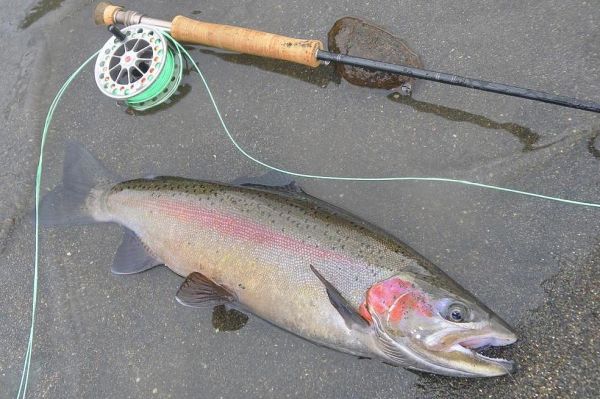
Tight lines guys
Mike |
|
|
| Back to Top |
|
|
|
|
| |
| COMMENTS |
|
| Great post, Mike! I miss the Tongariro... |
|
|
|
| Jon Novoselac | Tue 23rd April, 2013 | |
|
|
|
| |
|
|
|